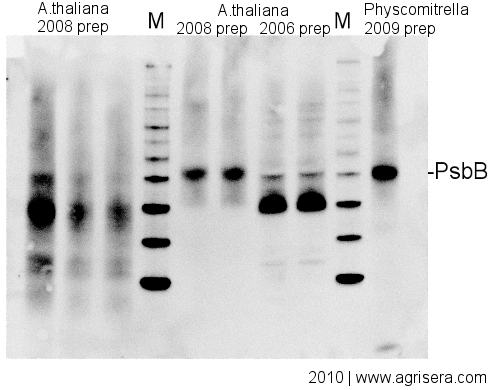| Protein extracts can degrade during prolonged storage at -20°C. A safer method of preservation is to complete the gel electrophoresis, followed by a protein transfer to a nitrocellulose or PVDF membrane, which is then air dried, protein side up (marked clearly for the future use). Membranes prepared in this way can be stored for up to 6 months in RT between sheets of Whatman, in a clean box. The benefits of this procedure include:
Using this procedure, samples will be preserved and antibodies can be quickly validated using membranes prepared in advance. This will save precious time for the project. For proteins of low expression, like transcription factors, specific organs and cellular fractions have to be used to allow higher concentration of the target protein. Use this e-plant resource to check for expression levels and localization of a target protein in the species you are working with. Agrisera Standard Western blot protocol |  Prolonged storage of protein samples can contribute to degradation of a target protein as shown for PsbB in samples stored for 2 years in -20°C. |
Latest
Is wild type a wild type?2025-12-29 Why an antibody may detect tagged protein but not endogenous one and in some cases endogenous protein but not its tagged version?
2025-10-30 Calclulated and aparent molecular weight of detected protein is different, why?
2025-10-09 How to chose right loading control for Western blot?
2025-10-06 Is an antibody going to work in a technique I am planning to use it in?
2025-09-30 Antibody reactivity to recombinant protein,does not validate antibody specificity in endogenous sample
2025-08-20 Can aggregated antibody be still used?
2025-08-15 Blot Once, Probe Twice - when such approach can be beneficial?
2025-07-31 Why should glycerol not be added, to stabilize antibodies in serum?
2025-06-27 Can methanol in transfer buffer be replaced by a less toxic alternative?
2025-05-12
Archive
- December - 2025
- October - 2025
- September - 2025
- August - 2025
- July - 2025
- June - 2025
- May - 2025
- April - 2025
- March - 2025
- February - 2025
- January - 2025
- December - 2024
- November - 2024
- September - 2024
- July - 2024
- June - 2024
- May - 2024
- March - 2024
- February - 2024
- December - 2023
- November - 2023
- September - 2023
- July - 2023
- May - 2023
- March - 2023
- January - 2023
- December - 2022
- November - 2022
- October - 2022
- September - 2022
- August - 2022
- June - 2022
- May - 2022
- March - 2022
- February - 2022
- January - 2022
- November - 2021
- October - 2021
- August - 2021
- June - 2021
- May - 2021
- April - 2021
- March - 2021
- February - 2021
- January - 2021
- December - 2020
- November - 2020
- October - 2020
- September - 2020
- August - 2020
- July - 2020
- June - 2020
- May - 2020
- April - 2020
- March - 2020
- January - 2020
- November - 2019
- October - 2019
- March - 2019
- April - 2017
- February - 2017
- May - 2016
- February - 2014
- September - 2013
- December - 2010
